Muswell Hill takes its name from a medieval holy well and its hill-top location. The ‘mossy well’ became a place of pilgrimage after a Scottish king was said to have been cured here drinking the water. By the early 1800s, Belle Vue Lodge stood on the site of these premises. In 1900, it was replaced by the Express Dairy tea room, with a milk depot at the rear. In the early 1980s, the property was converted into licensed premises.
A photograph and text about The Mossy Well.
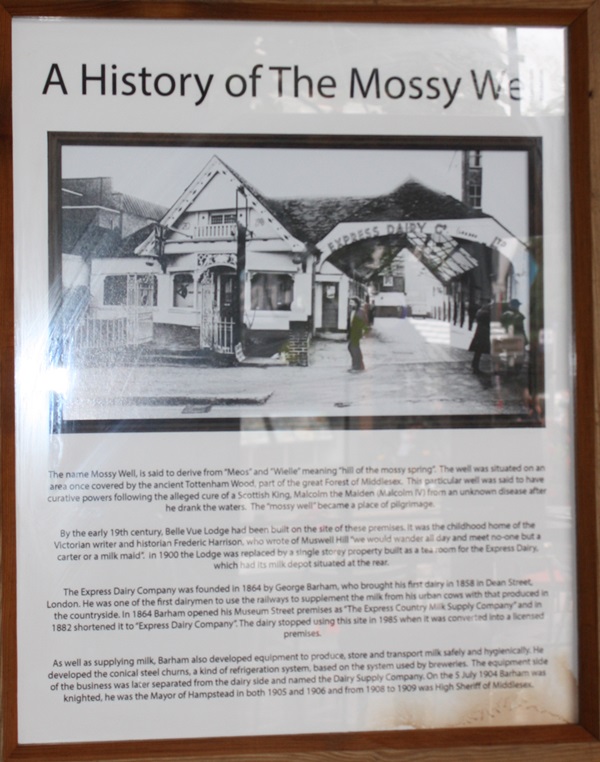
The text reads: The name Mossy Well, is said to derive from “Meos” and “Wielle” meaning “hill of the mossy spring”. The well was situated on an area once covered by the ancient Tottenham Wood, part of the great Forest of Middlesex. This particular well was said to have curative powers following the alleged cure of a Scottish King, Malcom the Maiden (Malcolm IV) from an unknown disease after he drank the waters. The “mossy well” became a place of pilgrimage.
By the early 19th century, Belle Vue Lodge had been built on the site of these premises. It was the childhood home of the Victorian writer and historian Frederic Harrison, who wrote of Muswell Hill “we would wander all day and meet no-one but a carter or a milk maid”. In 1990 the Lodge was replaced by a single storey property built as a tea room for the Express Diary, which had its milk depot situated at the rear.
The Express Dairy Company was founded in 1864 by George Barham, who brought his first dairy in 1858 in Dean Street, London. He was one of the first dairymen to use the railways to supplement the milk from his urban cows with that produced in the countryside. In 1864 Barham opened his Museum Street premises as The Express Country Milk Supply Company and in 1882 shortened it to Express Dairy Company. The dairy stopped using this site in 1985 when it was converted into a licensed premises.
As well as supplying milk, Barham also developed equipment to produce, store and transport milk safely and hygienically. He developed the conical steel churns, a kind of refrigeration system, based on the system used by breweries. The equipment side of the business was later separated from the dairy side and named the Dairy Supply Company. On the 5 July 1904 Barham was knighted, he was the Mayor of Hampstead in both 1905 and 1906 and from 1908 to 1909 was High Sherriff of Middlesex.
A 1912 advert for a Melotte Cream Separator that would have been widely used in dairies throughout the UK.
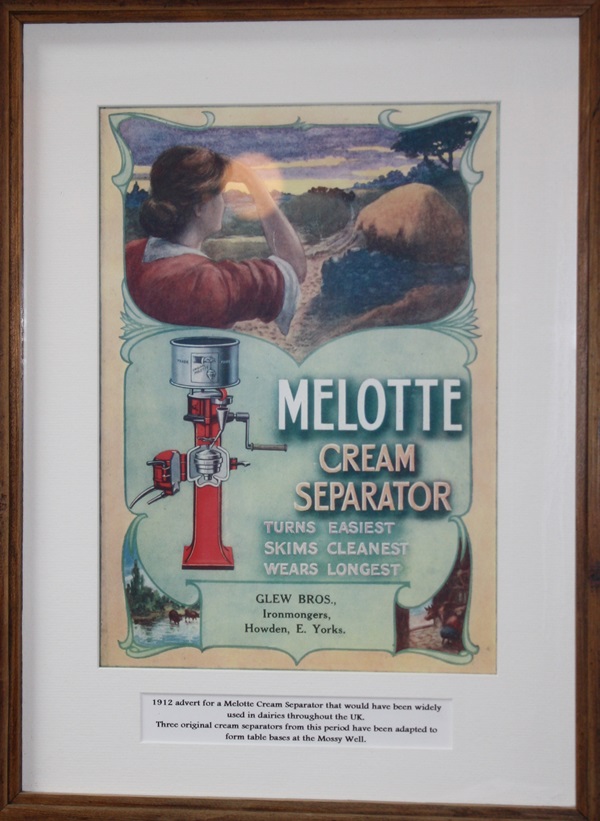
Three original cream separators from this period have been adapted to form table bases at the Mossy Well.
A photograph of a view of the top of Muswell Hill in the 1920s photographed from the Express Dairy building.
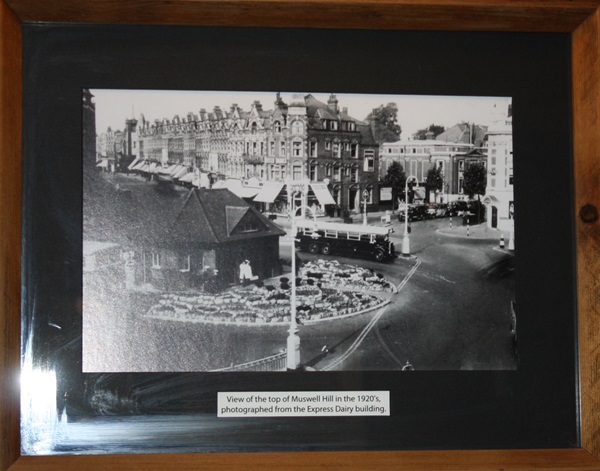
A photograph of the top of the Muswell Hill in the 1970s showing part of the Express Dairy building.
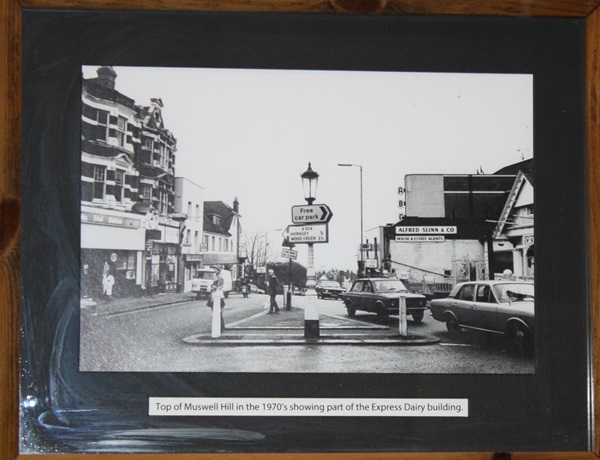
A photograph of an employee at work in the milk dispatch area at the Express Dairy in 1950.

A photograph of milk bottles rising at the Express Dairy 1950.
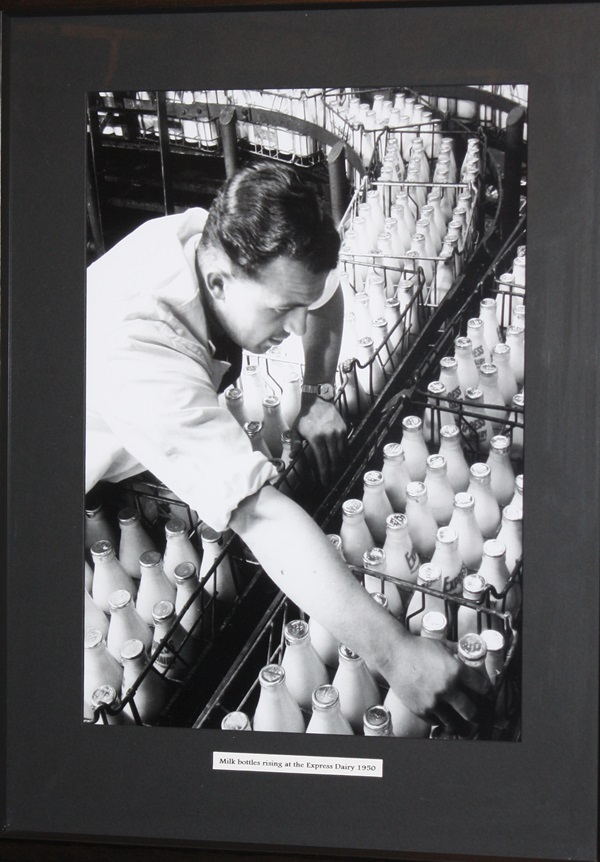
Plan drawings for the proposed Express Dairy Company premises at Muswell Hill received on the 4 January 1900.
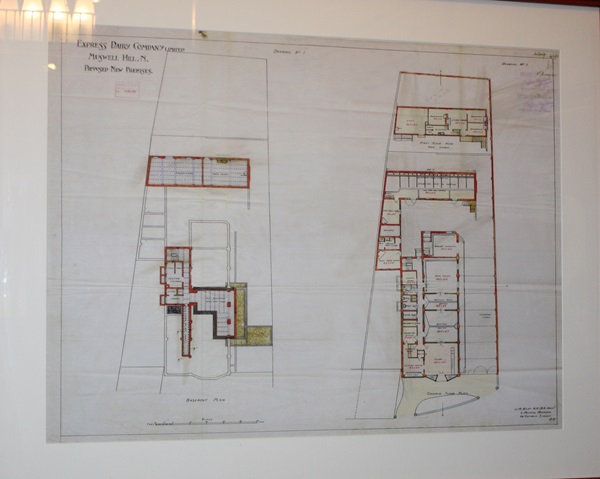
These were originally disapproved on the 8 January but passed on the 5 February 1900.
A print of Sir George Barham in ceremonial clothing, from a photograph by Elliott and Fry c1906.
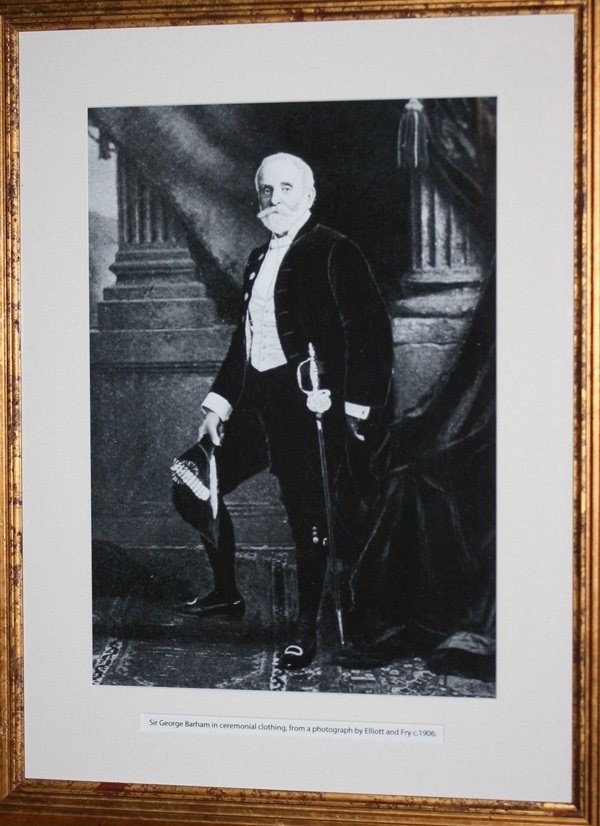
A photograph of Frederic Harrison, historian and writer, photographed in his study c1900.
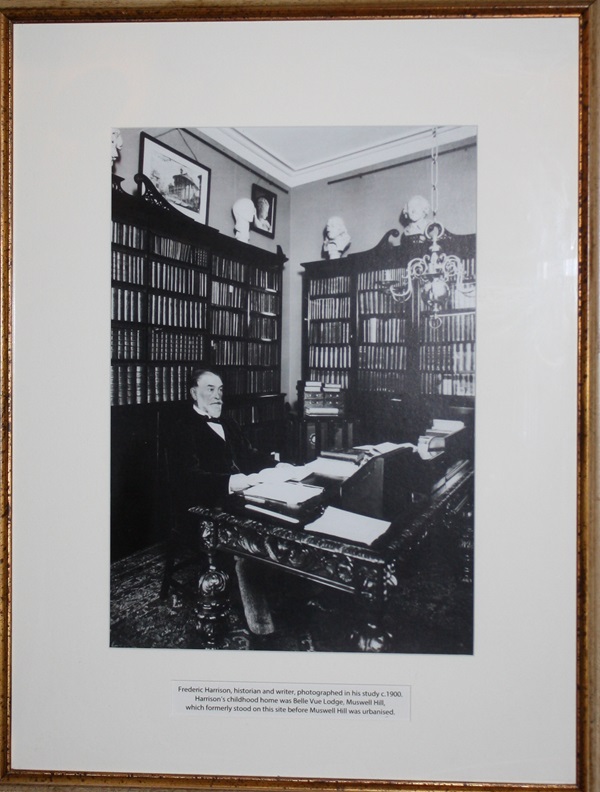
Harrison’s childhood home was Belle Vue Lodge, Muswell Hill, which formerly stood on this site before Muswell Hill was urbanised.
A photograph and text about Muswell Hill.
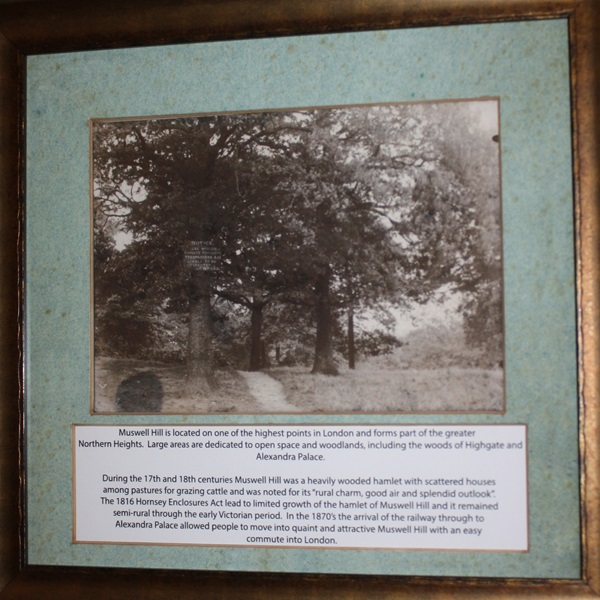
The text reads: Muswell Hill is located on one of the highest points in London and forms part of the greater Northern Heights. Large areas are dedicated to open space and woodlands, including the woods of Highgate and Alexandra Palace.
During the 17th and 18th centuries Muswell Hill was a heavily wooded hamlet with scattered houses among the pastures for grazing cattle and was noted for its “rural charm, good air and splendid outlook”. The 1816 Hornsey Enclosures Act lead to limited growth of the hamlet of Muswell Hill and it remained semi-rural through the early Victorian period. In the 1870s the arrival of the railway through to Alexandra Palace allowed people to move into quaint and attractive Muswell Hill with an easy commute into London.
An illustration and text about Alexandra Palace.
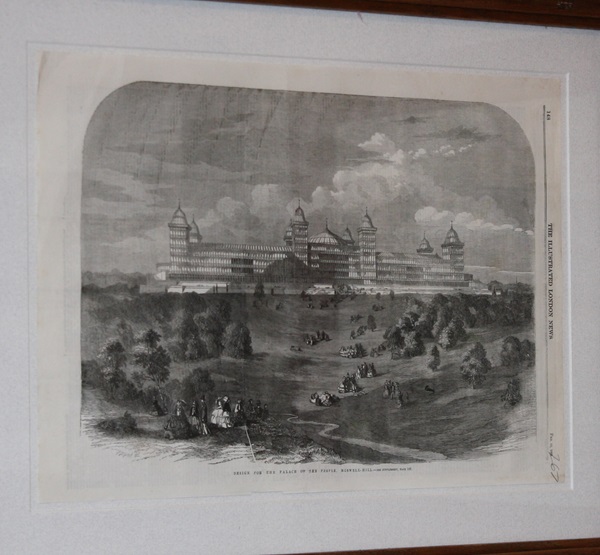
The text reads: The public park in the grounds of Alexandra Palace was laid out by Alexander McKenzie and opened in 1863 with the addition of actual buildings coming later. The selection of original pages here are all from the Illustrated London News and show various designs proposed for the ‘Palace of the People’
On his death in 1856, Thomas Rhodes’ grandchildren inherited Tottenham Wood Farm, a large dairy farm between the villages of Muswell Hill, Wood Green and Hornsey. Influenced by the success of the Crystal Palace they drew up a scheme for a similar venture for a North London “Palace of the People”. Of the 450 acres, 150 acres was to be set aside as park and the remaining 300 acres was sold to finance the project.
By 1858, a layout to the grounds had been submitted by Mr John Spencer of Bowood but nothing came of these early plans. Mr Francis Fuller then made a detailed survey of Muswell Hill Park, dated 1860, with a view to opening the park as an amusement centre with a building to rival the Crystal Palace of which he had been manager for three years. Fuller failed to raise the necessary funding and so his scheme was also shelved.
In 1863, the Alexandra Palace Park Committee was formed with the purpose of acquiring land in order to lay it out as a place for public recreation and amusement. The original Alexandra Palace was the exhibition building of the Great International Exhibition on 1862 which was re-erected in Alexandra Palace and opened in 1873. It burnt down sixteen days after the opening but was rebuilt by Meeson and Johnson and re-opened in 1875.
An original page from The Graphic magazine dated May 1875.
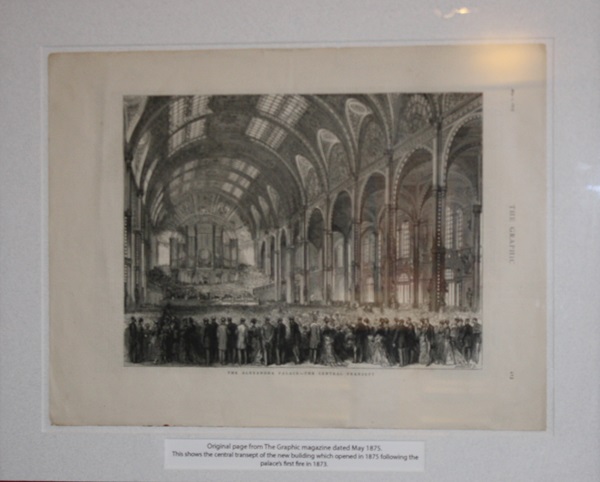
This shows the central transept of the new building which opened in 1875 following the palaces first fire in 1873.
A photograph and text about Muswell Hill Station.
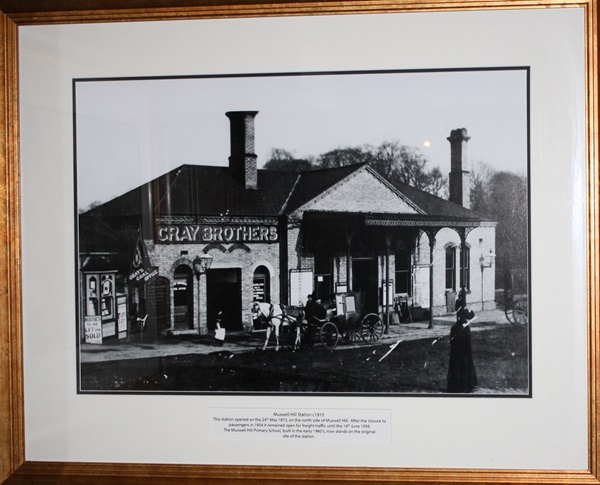
The text reads: This station opened on the 24 May 1873, on the north side of Muswell Hill. After the closure to passengers in 1954 it remained open for freight traffic until the 14 June 1956. The Muswell Hill Primary School, built in the early 1960s, now stands on the original site of the station.
A photograph and text about Muswell Hill Station.
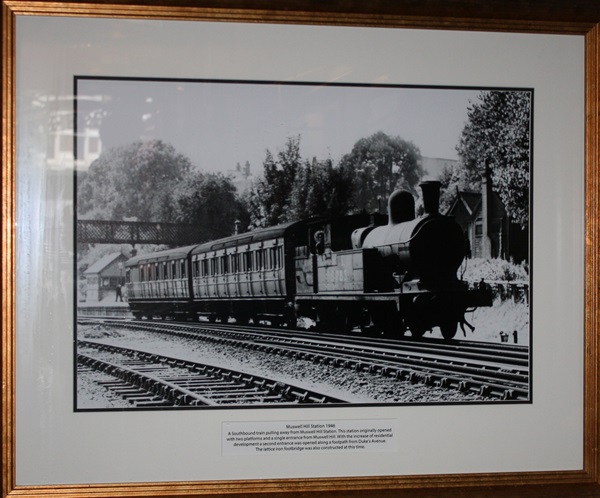
The text reads: A southbound train pulling away from Muswell Hill Station. This station originally opened with two platforms and a single entrance from Muswell Hill. With the increase of residential development a second entrance was opened along a footpath from Duke’s Avenue. The lattice iron footbridge was also constructed at this time.
Illustrations and text about the history of brewing beer.
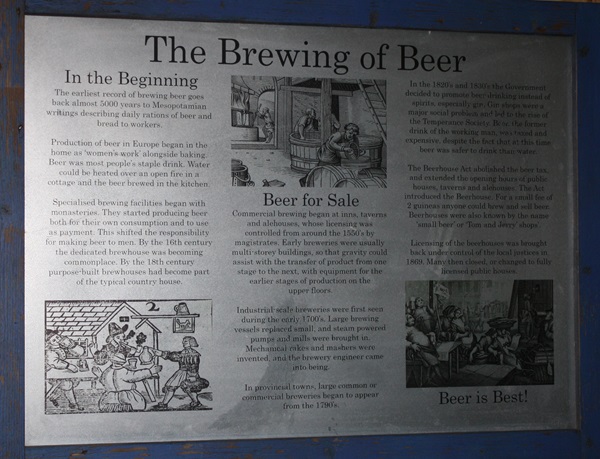
The text reads: The earliest record of brewing beer goes back almost 500 years to Mesopotamian writings describing daily rations of beer and bread to workers.
Production of beer in Europe began in the home as women’s work alongside baking. Beer was most people’s staple drink. Water could be heated over an open fire in a cottage and the beer brewed in the kitchen.
Specialised brewing facilities began with monasteries. They started producing beer both for their own consumption and to use as payment. This shifted the responsibility for making beer to men. By the 16th century the dedicated brewhouse was becoming commonplace. By the 18th century purpose-built brewhouses had become part of the typical country house.
Commercial brewing began at inns, taverns and alehouses, whose licensing was controlled from around the 1550s by magistrates. Early breweries were usually multi-story buildings, so that gravity could assist with the transfer of product form one stage to the next, with equipment for the earlier stages of production on the upper floors.
Industrial-scale breweries were first seen during the early 1700’s. Large brewing vessels replaced small, and steam powered pumps and mills were brought in. Mechanical rakes and mashers were invented, and the brewery engineer came into being.
In provincial towns, large common or commercial breweries began to appear from the 1790s.
In the 1820s and 1830s the Government decided to promote beer drinking instead of spirits, especially gin. Gin ships were a major social problem and led to the rise of the Temperance Society. Beer, the former drink of the working man, was taxed and expensive, despite the fact that at this time beer was safer to drink than water.
The Beerhouse Act abolished the beer tax, and extended the opening hours of public houses, taverns and alehouses. The Act introduced the Beerhouse. For a small fee of 2 guineas anyone could brew and sell beer. Beerhouses were also known by the name small beer or Tom and Jerry shops.
Licensing of the Beerhouses was brought back under control of the local justices in 1869. Many then closed, or changed to fully licensed public houses.
An original painting by Richard Robbins.
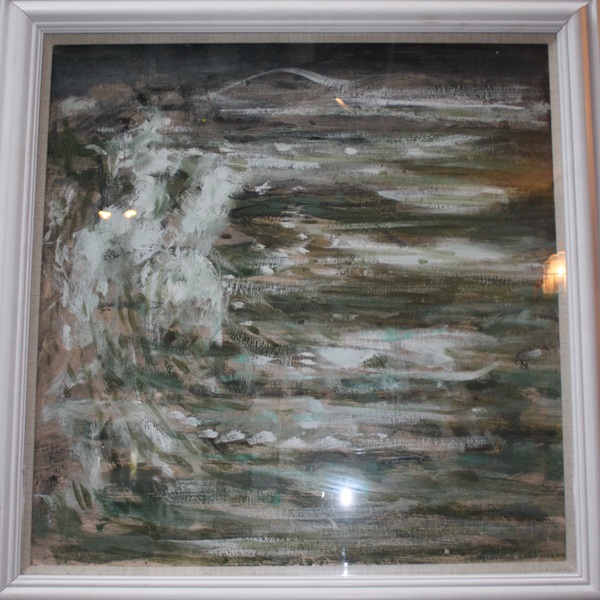
The text reads: This original painting was donated to The Mossy Well by Ray Blakeley, a close personal friend of the late artist, Richard Robbins. Richard gifted this painting to Ray one Christmas along with a hand painted card. They were friends for over 55 years. Ray speaks fondly of Richard, “he had a dry sense of humour and we would go to the pub together often. He had a dog called Fanny, don’t laugh, and would stand in Highbury Hill every morning calling out in loud voice, “Fanny where are you?”. Sometimes his wife Brenda stood with him. She had much the same sense of humour”.
Richard was an artist who painted and sculpted prolifically. A former head of fine art at Middlesex University, he sought to convey his turbulent spirit and love of nature through his art.
Richard was born in Hampstead Garden Suburb, North London and went to King Alfred and University College schools before going to Dauntsey’s school in Wiltshire, after the outbreak of the Second World War. Following a spell in the army with the 21st Field Artillery, he went to New College Oxford, to read English Literature; played golf for the university and emerged determined to become an artist. After periods at Goldsmiths College, Ruskins and the Slade School of Art, Richard taught art at Belmont School for six years from 1952.
Richard moved on to Camberwell School of Art and Hornsey School of Art, later incorporated in Middlesex University, where he was head of painting from 1984 and 1990 and then head of the school of fine art until 1993, when he was made an honorary professor of fine art and retired from teaching. He was elected an honorary member of the Royal Society of British Artists in 2004.
Richard adored colour and he was fascinated by changing patterns of light, weather and season. For a time he concentrated on the Hampstead ponds of North London and this painting is one of those pieces, although Ray was never sure of its title.
His home in Muswell Hill, with walls covered with pictures, shelves with sculpture and a collection of golf clubs in the front hall, was the scene of regular generous but simple hospitality and vigorous discussion with his much-loved second wife, Brenda, whom he married in 1961.
A print from the original watercolour From Muswell Hill, by J Hardy, c1835.
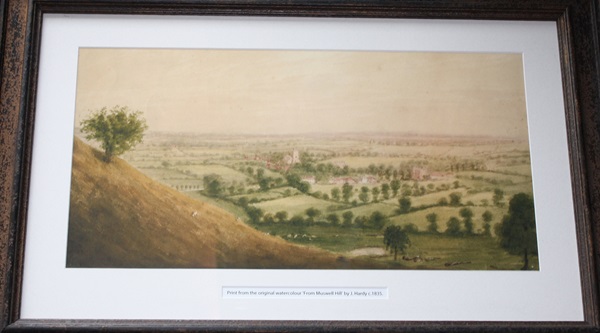
A painting entitled into The Woods VI, by Jane Human.
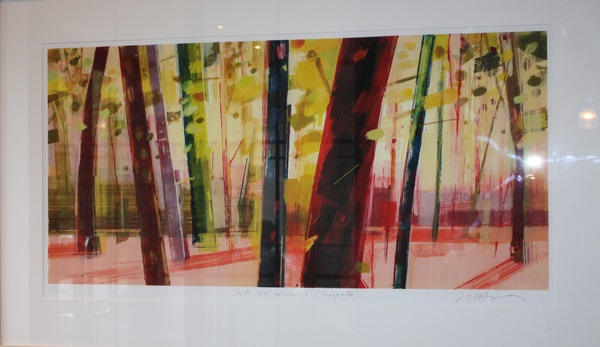
Jane Human is a painter and printmaker whose primary focus is landscape and the exploration of a sense of place. She has lived in North London many years. The inspiration for this ongoing series of paintings began with an early spring walk through Highgate Woods, moments of warm light filtering through acid bright, newly unfurling leaves.
“I’m interested in places which reveal their beauty slowly, and reward patient looking. Everything starts with making observational drawings and paintings in situ, as the experience of actually being there, taking account of the light, the weather and the moment are all vital to the development of any visual ideas. This series allows for small changes in colour, mark-making and structure to become important and for memory to start to play its part as the theme develops”.
An illustration entitled Haringey, by Stephen Walker.
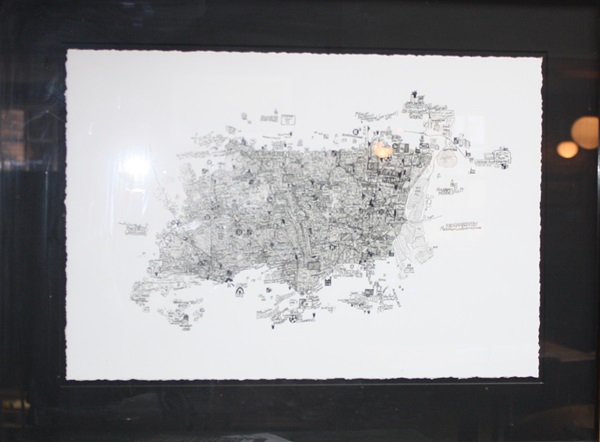
The text reads: In 1995 Stephen graduated from Middlesex University with a BTEC Diploma in Art and Design Foundation and continued onto the Royal College of Art, leaving in 2001 with an MA in Fine Art Printmaking.
His drawings are a tangle of signs, words and images that draw the viewer into the artist’s intricate worlds. His work is crowded with today’s cultural symbols and obsessive tendencies; but it also celebrates traditional techniques, craftsmanship and romantic notions of place.
Walter’s major project The Island, London Series which this print Haringey is a part of, was published in 2008 and has enjoyed sustained critical acclaim ever since. In each of these borough prints, Walter combines history, trivia, personal experience, local knowledge and imaginative additions to creatively explore an area in all its contradictory complexity.
An oil painting entitled Muswell Hill, by Ellie Spafford.
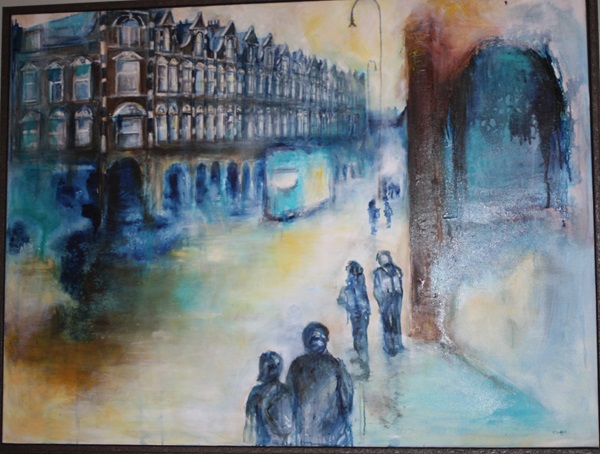
The text reads: “A love of landscape is central to my work. Using a series of drawings as a starting point, I layer and change the image concentrating on depth of colour and texture. I love experimenting with different mediums and pigments. I paint with cloths, sticks and brushes. I revel in the investigative process, discovering new effects and allowing the paint to pool and drip.
After studying in Bristol, I’ve worked abroad for a few years. I’ve done projects based on the Madagascan rainforest, the Hangzhou in China and the island of Guernsey, where I was brought up. I live in North London and work at Euroart Studios.
London is a fascinating place to work. I’m inspired by all the textures and Gothic Architecture. I enjoy the different effects of the sunshine or mist on the environment. Muswell Hill is a beautiful location to concentrate on. I love the stunning Edwardian buildings and arched street lamps”.
An illustration entitled Muswell Hill Express Dairy, by Adam Doughty.
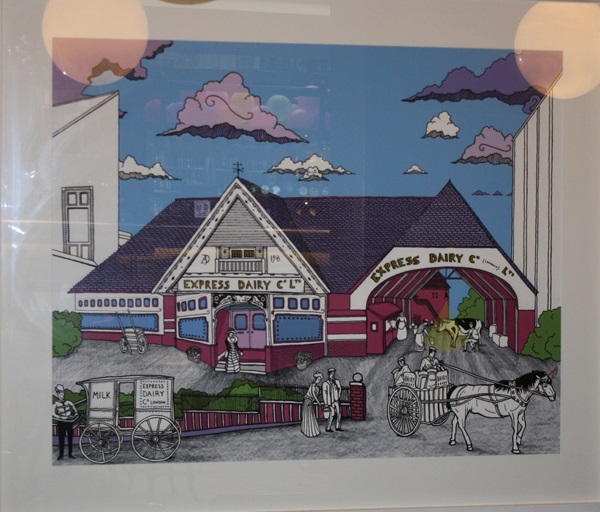
The text reads: This illustration was commissioned by J D Wetherspoon from London based artist Adam Doughty. Adam developed his unique freehand and drawing style whilst studying illustration at the Norwich School of Art and Design. After graduating in 2006, Adam has taken on many creative projects but his main subject of inspiration has always been London.
“I have a huge interest in London. I love its diversity, grittiness and the way it’s constantly changing. I enjoy delving into its rich historical past and uncovering new information. Because London has undergone so much regeneration in recent years, I feel it’s important to document the changes and to capture the spirit of the times.
Muswell Hill is a very interesting area with great historical importance. Whilst creating Muswell Hill Express Dairy, I felt it was necessary to incorporate elements of both past and present. I love the Victorian architecture of the dairy building and enjoyed recreating it using pen, pencil and an aesthetically pleasing colour palette”.
External photograph of the building – main entrance.
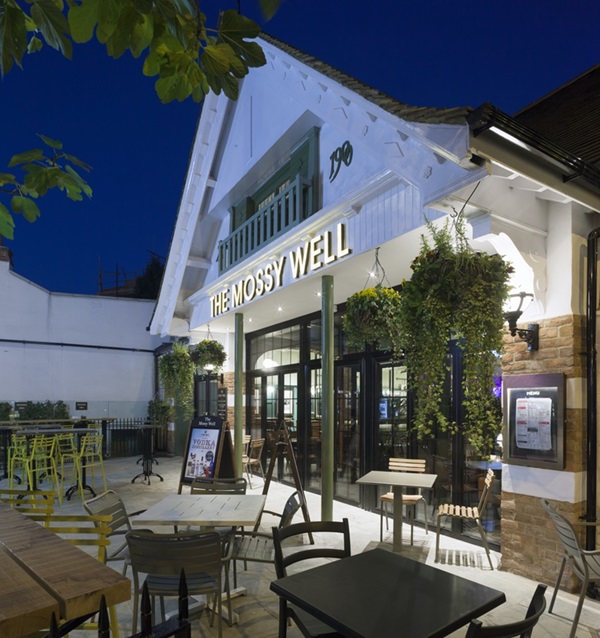
If you have information on the history of this pub, then we’d like you to share it with us. Please e-mail all information to: pubhistories@jdwetherspoon.co.uk